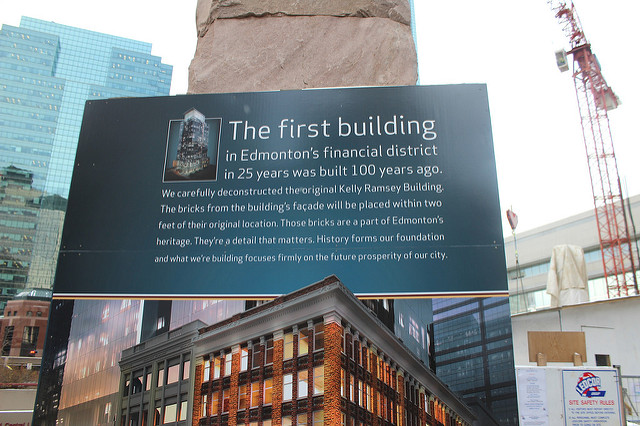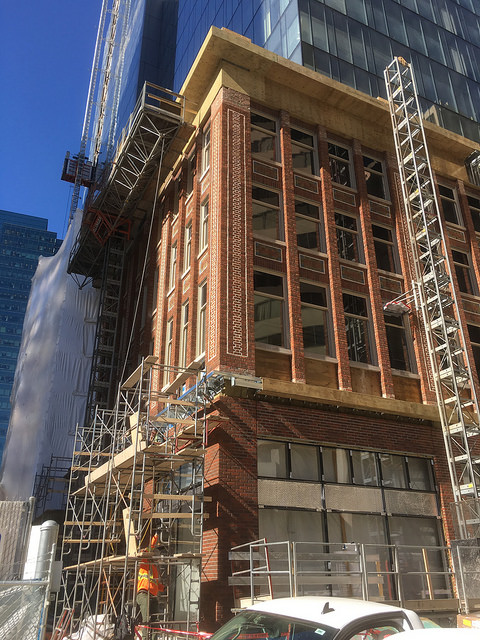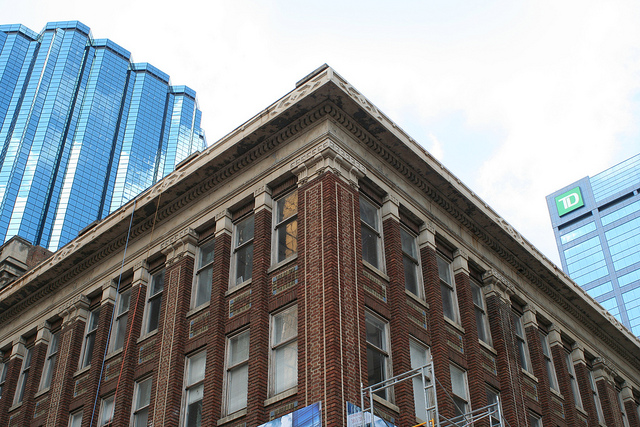Echoes of one of Edmonton’s earliest successful retail enterprises can be found in the new Kelly Ramsey Tower now being completed downtown. Bricks from the Kelly and Ramsey blocks are incorporated in the four-storey podium of the tower, connecting the modern day with a little empire built 100 years ago by a man called Edmonton’s Merchant Prince.

“KELLEY RAMSEY” Photo by Flickr user jasonwoodhead23 © January 1, 2000 Creative Commons License – https://flic.kr/p/q7cEeS
“Kelley Ramsey tower” Photo by Flickr user jasonwoodhead23 © March 18, 2016 Creative Commons License – https://flic.kr/p/Fsrn9k
“Kelly Ramsey Building” Photo by Flickr user Mack Male © January 18, 2016 Creative Commons License – https://flic.kr/p/Df2Yi5
James Ramsey was a man ahead of his time. He introduced to Edmonton a scale of retailing that had never been tried before and, in so doing, changed the way Edmontonians shopped.
Ramsey was born in Imlay City, Michigan in 1864 and was four years old when his family emigrated to Oxford County, Ontario. At 13, he started working at a general store in Plattsville, Ontario, and a trip to Edmonton in 1910 made him realize the potential of the west.
He met a man named Robert Tegler who was planning to build a modern business block. Ramsey was excited by possibilities as he headed back to Ontario. When Tegler then forwarded rental details by telegram, the terms were so good that Ramsey caught the next train back to Edmonton. He quickly rolled up his sleeves and began readying a store for the main floor of Tegler’s new building on the corner of First Street and Elizabeth Street (now 102nd Avenue).
The Tegler Block started to rise in the spring of 1911 and Ramsey’s store opened September 3rd, 1911, occupying 18,000 square feet. The original capital expense was $19,000 — $8,000 for fixtures, $6,000 for freight and $5,000 for expenses.

Tegler Block, Edmonton, Alberta ca. 1912. “Occupied by Jas. Ramsey, Limited and F.W. Woolworth Co., Ltd.” Image courtesy of the City of Edmonton Archives EA-796-3.
“SE corner, Kelly-Ramsey Building” Photo by Flickr user Colby Cash © June 30, 2013 Creative Commons License – https://flic.kr/p/eZf1mq
Business the first day totalled $7,500 and the new venture was an immediate hit. Within a year expansion was needed and a second was completed the following year as the operation took over a business block east of the Tegler on 100A Street.
By the 1920s, the business sprawled over more than 175,000 square feet including the main floor of the Kelly Block, built in 1914 at 10040 101A Avenue. In 1927, at the height of the business, Ramsey constructed the Ramsey Block at 10048 101A Avenue. Both buildings were severely damaged by fire in 2009.
In its early days of operation, Ramsey’s business employed 60 people and that soon grew to 200 and then more than 300. The operation was a success because Ramsey was an innovator. One example of that innovation involved how goods were priced.
Since Edmonton’s beginnings, storekeepers rounded everything to five cents because that was the lowest denomination coin in general circulation. The one-cent piece was a curiosity in Edmonton but Ramsey felt that should change. He began pricing his merchandise in odd cents — purses for $2.69, a package of socks for 49 cents and so on. At first, there was disbelief and opposition on the part of storekeepers, clerks and customers who suddenly had to adjust to this splitting of the retail dollar. But, as the banks caught on and began bringing in enough pennies to fill the demand, the idea took off.

For the next 17 years, his store was Edmonton’s most dominant retailer. “The Ramsey store, the Ramsey business and the Ramsey methods stand for the last word in the handling of a great modern store business,” observed a 1918 article in the Edmonton Bulletin. That feature, headlined “The James Ramsey Departmental Store,” noted the business offered 20 departments including groceries, carpets and house furnishings, even corsets and underwear.
“It is the boast of the firm that everything that is required in the home can be secured without leaving the store,” the article said. The store also featured a mail order service and four catalogues a year provided out-of-town shoppers with the opportunity to buy — an idea that was later to garner considerable success for chains like Eaton’s and Sears.
A feature on him published in volume three of Alberta, Past and Present put it this way: “Broad practical experience has given him a comprehensive understanding of the principles of merchandising and no detail of the business escapes his observation, while the larger factors in his affairs are directed with notable assurance and power. He has closely studied trade conditions and the demands of the public and employs the most modern and progressive methods in the operation of his establishment, which is high class in every particular.”
Always on the hunt for new merchandise, Ramsey travelled extensively, visiting many countries around the globe. Remember that these were the days long before jet travel and so the voyages were made by steamer, rail and automobile.
It’s not clear who coined the title “Edmonton’s Merchant Prince,” but the label stuck.
Along the way, Ramsey was elected as alderman in 1915 and 1916, and in April 1917 was chosen by voters as Conservative MLA representing his riding of East Edmonton until 1921. He was also actively involved with the Chamber of Commerce and the Board of Trade and helped establish the Edmonton Stock Yards.
In recognition of his service to the community, Ramsey was appointed Honorary Colonel of the Edmonton Regiment. Ramsey was married twice and fathered three children — daughters Ruby and Clara and a son, Lt. Thomas Norman Ramsey, who served in the First World War with the 49th Battalion of the Edmonton Regiment.
Ramsey decided to retire in 1928 and sold his little retail empire to the T. Eaton Company for $1 million. Afterwards he spent summers in Edmonton and travelled to warmer climates between October and May. Edmonton’s Merchant Prince died suddenly at his winter home at Cable Beach, Nassau, Bahama on December 25, 1939. He was 75 years old.
Lawrence Herzog © 2016
